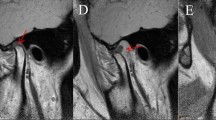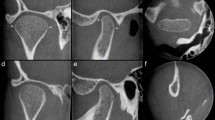Abstract
Objectives
The aim of this study was to evaluate the interexaminer reliability for tomographic findings in degenerative temporomandibular joint disease and its agreement with clinical diagnosis.
Methods
Women aged 18 and 60 years were invited to participate in this research. All participants were evaluated by a single experienced examiner according to the Research Diagnostic Criteria for Temporomandibular Disorders (RDC/TMD). Group 1 was comprised of TMJs with Degenerative Joint Disease (DJD). Group 2 was comprised of healthy TMJs, without any signs and/or symptoms of TMD. All CBCT images were evaluated by 2 calibrated examiners for the image evaluation criteria but blinded for the clinical diagnosis.
Results
From the 194 women evaluated, 41 were included, with a mean age of 35.23 (± 14.06) years. Group 1 was comprised of 26 TMJs with DJD and group 2 of 36 asymptomatic TMJs. The interexaminer reliability was κ = 0.706 (p < 0.000), while agreement between clinical and tomographic findings were κ = 0.301 (p = 0.01) and κ = 0.273 (p = 0.02) for each examiner. The use of CBCT as a diagnostic test had shown sensitivity and specificity values of 61.5% and 75%, respectively.
Conclusions
The interexaminer reliability for tomographic findings was strong. However, the agreement between clinical and tomographic findings was reasonable, for both examiners.



Similar content being viewed by others
References
De Leeuw R, Klasser GD. Orofacial Pain. Guidelines for Assessment, Diagnosis and Management. . 6th ed. Hanover Park: Quintessence; 2018.
Talaat W, Al Bayatti S, Al KS. CBCT analysis of bony changes associated with temporomandibular disorders. Cranio. 2016;34(2):88–94. https://doi.org/10.1179/2151090315Y.0000000002.
Pantoja LLQ, de Toledo IP, Pupo YM, Porporatti AL, De Luca CG, Zwir LF, et al. Prevalence of degenerative joint disease of the temporomandibular joint: a systematic review. Clin Oral Investig. 2019;23(5):2475–88. https://doi.org/10.1007/s00784-018-2664-y.
Schiffman E, Ohrbach R, Truelove E, Look J, Anderson G, Goulet JP, et al. Diagnostic criteria for temporomandibular disorders (DC/TMD) for clinical and research applications: recommendations of the International RDC/TMD Consortium Network* and Orofacial Pain Special Interest Groupdagger. J Oral Facial Pain Headache. 2014;28(1):6–27. https://doi.org/10.11607/jop.1151.
dos Anjos Pontual ML, Freire JS, Barbosa JM, Frazao MA, dos Anjos PA. Evaluation of bone changes in the temporomandibular joint using cone beam CT. Dentomaxillofac Radiol. 2012;41(1):24–9. https://doi.org/10.1259/dmfr/17815139.
Petersson A. What you can and cannot see in TMJ imaging–an overview related to the RDC/TMD diagnostic system. J Oral Rehabil. 2010;37(10):771–8. https://doi.org/10.1111/j.1365-2842.2010.02108.x.
Bag AK, Gaddikeri S, Singhal A, Hardin S, Tran BD, Medina JA, et al. Imaging of the temporomandibular joint: An update. World J Radiol. 2014;6(8):567–82. https://doi.org/10.4329/wjr.v6.i8.567.
Schulze D, Heiland M, Thurmann H, Adam G. Radiation exposure during midfacial imaging using 4- and 16-slice computed tomography, cone beam computed tomography systems and conventional radiography. Dentomaxillofac Radiol. 2004;33(2):83–6. https://doi.org/10.1259/dmfr/28403350.
Sinha VP, Pradhan H, Gupta H, Mohammad S, Singh RK, Mehrotra D, et al. Efficacy of plain radiographs, CT scan, MRI and ultra sonography in temporomandibular joint disorders. Natl J Maxillofac Surg. 2012;3(1):2–9. https://doi.org/10.4103/0975-5950.102138.
Barbieri AA, Costa ALF, Perez Gomes JP, Ricardo ALF, Braz-Silva PH, Lopes S. Association of volume and voxel intensity of the articular disc and lateral pterygoid muscle in migraine patients: a study with magnetic resonance imaging. Acta Odontol Scand. 2020;78(3):189–95. https://doi.org/10.1080/00016357.2019.1676917.
Pupo YM, Pantoja LL, Veiga FF, Stechman-Neto J, Zwir LF, Farago PV, et al. Diagnostic validity of clinical protocols to assess temporomandibular disk displacement disorders: a meta-analysis. Oral Surg Oral Med Oral Pathol Oral Radiol. 2016;122(5):572–86. https://doi.org/10.1016/j.oooo.2016.07.004.
Schiffman E, Ohrbach R. Executive summary of the Diagnostic criteria for temporomandibular disorders for clinical and research applications. J Am Dent Assoc. 2016;147(6):438–45. https://doi.org/10.1016/j.adaj.2016.01.007.
Ahmad M, Hollender L, Anderson Q, Kartha K, Ohrbach R, Truelove EL, et al. Research diagnostic criteria for temporomandibular disorders (RDC/TMD): development of image analysis criteria and examiner reliability for image analysis. Oral Surg Oral Med Oral Pathol Oral Radiol Endod. 2009;107(6):844–60. https://doi.org/10.1016/j.tripleo.2009.02.023.
Al-Ekrish AA, Al-Juhani HO, Alhaidari RI, Alfaleh WM. Comparative study of the prevalence of temporomandibular joint osteoarthritic changes in cone beam computed tomograms of patients with or without temporomandibular disorder. Oral Surg Oral Med Oral Pathol Oral Radiol. 2015;120(1):78–85. https://doi.org/10.1016/j.oooo.2015.04.008.
Hilgenberg-Sydney PB, Bonotto DV, Stechman-Neto J, Zwir LF, Pacheco-Pereira C, Canto GL, et al. Diagnostic validity of CT to assess degenerative temporomandibular joint disease: a systematic review. Dentomaxillofac Radiol. 2018;47(5):20170389. https://doi.org/10.1259/dmfr.20170389.
Vandenbroucke JP, von Elm E, Altman DG, Gotzsche PC, Mulrow CD, Pocock SJ, et al. Strengthening the reporting of observational studies in epidemiology (STROBE): explanation and elaboration. Ann Intern Med. 2007;147(8):W163–94. https://doi.org/10.7326/0003-4819-147-8-200710160-00010-w1.
Bossuyt PM, Reitsma JB, Bruns DE, Gatsonis CA, Glasziou PP, Irwig L, et al. STARD 2015: an updated list of essential items for reporting diagnostic accuracy studies. BMJ. 2015;351:h5527. https://doi.org/10.1136/bmj.h5527.
Dworkin SF, LeResche L. Research diagnostic criteria for temporomandibular disorders: review, criteria, examinations and specifications, critique. J Craniomandib Disord. 1992;6(4):301–55.
Landis JR, Koch GG. The measurement of observer agreement for categorical data. Biometrics. 1977;33(1):159–74.
Alkhubaizi Q, Sorkin JD, Hochberg MC, Gordon SM. Risk factors for facial pain: data from the osteoarthritis initiative study. J Dent Oral Biol. 2017;2(3).
Kim K, Wojczynska A, Lee JY. The incidence of osteoarthritic change on computed tomography of Korean temporomandibular disorder patients diagnosed by RDC/TMD; a retrospective study. Acta Odontol Scand. 2016;74(5):337–42. https://doi.org/10.3109/00016357.2015.1136678.
Cevidanes LH, Walker D, Schilling J, Sugai J, Giannobile W, Paniagua B, et al. 3D osteoarthritic changes in TMJ condylar morphology correlates with specific systemic and local biomarkers of disease. Osteoarthritis Cartilage. 2014;22(10):1657–67. https://doi.org/10.1016/j.joca.2014.06.014.
Dias GM, Bonato LL, Guimaraes JP, Silva JN, Ferreira LA, Grossmann E, et al. A study of the association between sleep bruxism, low quality of sleep, and degenerative changes of the temporomandibular joint. J Craniofac Surg. 2015;26(8):2347–50. https://doi.org/10.1097/SCS.0000000000002084.
Iskanderani D, Alstergren P, Ekberg EC, Shi XQ, Hellen-Halme K. Web-based educational programme for temporomandibular joint assessment with cone-beam computed tomography. J Oral Rehabil. 2020. https://doi.org/10.1111/joor.13065.
Parikh R, Mathai A, Parikh S, Chandra Sekhar G, Thomas R. Understanding and using sensitivity, specificity and predictive values. Indian J Ophthalmol. 2008;56(1):45–50. https://doi.org/10.4103/0301-4738.37595.
De Luca CG, Pacheco-Pereira C, Aydinoz S, Major PW, Flores-Mir C, Gozal D. Diagnostic capability of biological markers in assessment of obstructive sleep apnea: a systematic review and meta-analysis. J Clin Sleep Med. 2015;11(1):27–36. https://doi.org/10.5664/jcsm.4358.
Mandrekar JN. Receiver operating characteristic curve in diagnostic test assessment. J Thorac Oncol. 2010;5(9):1315–6. https://doi.org/10.1097/JTO.0b013e3181ec173d.
Acknowledgements
The study was performed at Federal University of Paraná, School of Dentistry, Restorative Dentistry Department, to which the work should be credited.
Funding
This research was supported by authors, with no grants or funding organizations.
Author information
Authors and Affiliations
Corresponding author
Ethics declarations
Conflict of interest statement
The authors report no conflict of interest.
Ethics approval
This study was submitted to and approved by the local Committee on Ethics in Research (Cometica UFPR) under protocol of approval #3007331. All procedures followed were in accordance with the ethical standards of the responsible committee on human experimentation (institutional and national) and with the Helsinki Declaration of 1975, as revised in 2008.
Informed consent
Informed consent was obtained from all patients for being included in the study.
Additional information
Publisher's Note
Springer Nature remains neutral with regard to jurisdictional claims in published maps and institutional affiliations.
Rights and permissions
About this article
Cite this article
Hilgenberg-Sydney, P.B., Schenato, L.F., Marques, H.B. et al. Interexaminer reliability for tomographic findings in temporomandibular joint degenerative disease and its agreement with clinical diagnosis: a blinded controlled cross sectional study. Oral Radiol 38, 155–161 (2022). https://doi.org/10.1007/s11282-021-00539-1
Received:
Accepted:
Published:
Issue Date:
DOI: https://doi.org/10.1007/s11282-021-00539-1




